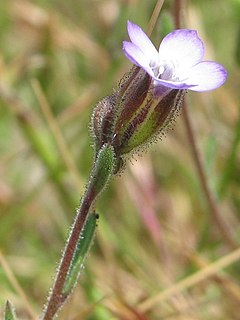
Gilia millefoliata is a species of flowering plant in the phlox family known by the common name manyleaf gilia. It is native to the coastline of Oregon and northern California, where it grows in sand dune habitat.

Abronia turbinata is a species of flowering plant in the four o'clock family known by the common name transmontane sand-verbena. It is native to eastern California and Oregon and western Nevada, where it grows in desert and plateau scrub.

Camissoniopsis micrantha is a species of flowering plant in the evening primrose family known by the common names miniature suncup or small evening primrose. This is a small, hairy annual herb producing a basal rosette of leaves. It is characterized by small yellow flowers with petals less than 5 millimeters long. The flowers dry to a reddish color as they close. This species is found in Arizona and California in the United States, along with Baja California in Mexico. It grows in sandy areas in a number of habitats, from beaches to inland slopes. It is the smallest member of the genus Camissoniopsis.
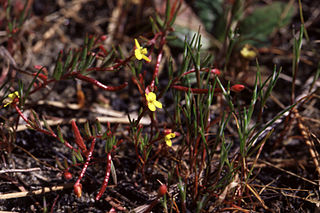
Camissonia strigulosa is a species of flowering plant in the evening primrose family known by the common name sandysoil suncup.

Arnica venosa is a rare California species of flowering plant in the family Asteraceae known by the common name Shasta County arnica. It should not be confused with the Mt. Shasta arnica, A. viscosa.

Astragalus gambelianus is a species of milkvetch known by the common name Gambel's dwarf milkvetch. It is native to California, with its distribution extending into Oregon to the north and Baja California to the south.
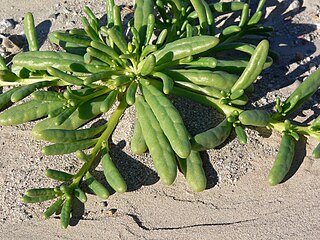
Cistanthe ambigua is a species of flowering plant in the family Montiaceae known by the common name desert pussypaws. It is native to the deserts of northern Mexico and Arizona and California in the United States, where it grows in sandy soils. This is an annual herb producing an upright stem to a maximum height of about 18 centimeters. The thick leaves are linear to spoon-shaped and grow along the stem rather than in a basal rosette at the base of the plant. The inflorescence is a tight cluster of white flowers with 3 to 5 petals each a few millimeters long. The fruit is a capsule containing up to 15 minute shiny black seeds.

Calyptridium monospermum, synonym Cistanthe monosperma, is a perennial plant in the miner's lettuce family (Montiaceae), known by the common name one-seeded pussypaws. It was formerly classified in the purslane family (Portulacaceae).
Calyptridium parryi, synonym Cistanthe parryi, is a species of flowering plant in the family Montiaceae. It is known by the common name Parry's pussypaws. It is native to the southwestern United States and Baja California. It is a small annual herb producing spreading stems up to about 11 centimeters long. There is a basal rosette of small, thick, spoon-shaped leaves no more than about 3 centimeters long, with many along the stems as well. The inflorescence is a cluster a few centimeters wide, with each bearing three white petals surrounded by a few thin sepals. The fruit is a capsule less than a centimeter wide.
Calyptridium pulchellum, synonym Cistanthe pulchella, is a rare species of flowering plant in the family Montiaceae. It is known by the common name mariposa pussypaws. It is endemic to the Sierra Nevada foothills of central California, where it is known from only a few scattered occurrences. It grows on barren patches of granite gravel in woodland and grasslands. It is a federally listed threatened species.

Calyptridium roseum, synonym Cistanthe rosea, is a species of flowering plant in the family Montiaceae commonly known as rosy pussypaws. It is native to the western United States from California to Wyoming, where it grows in forest and scrub. It is an annual herb, often reddish or pink in color, producing stems just a few centimeters long. The leaves are located in a rosette at the base and along the stems, and are up to 4 or 5 centimeters long. The inflorescence is a tiny cluster of white-edged thin sepals and two white petals, each no more than a millimeter long.

Campanula griffinii is a species of bellflower known by the common name Griffin's bellflower. It is endemic to California, where it grows in the North and Central Coast Ranges in chaparral habitat on serpentine soils. This is an annual herb producing a thin, erect stem up to 20 centimeters tall. The leathery leaves are linear in shape, toothed along the edges, and less than a centimeter long. The stem and foliage are sometimes reddish in color and may have stiff hairs. The small, cylindrical flower is pale blue to white and less than 4 millimeters long. The fruit is an oblong, ribbed capsule.
Chaenactis alpigena is a species of flowering plant in the daisy family known by the common name southern Sierra pincushion. It is native to the High Sierra Nevada and the White Mountains of California, extending in the latter just into Nevada.
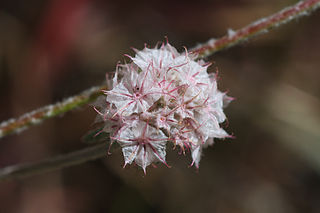
Chorizanthe membranacea is a species of flowering plant in the buckwheat family known by the common name pink spineflower. It is native to Oregon and California, where it is widespread and in some areas quite common. It can be found in a wide variety of habitats.
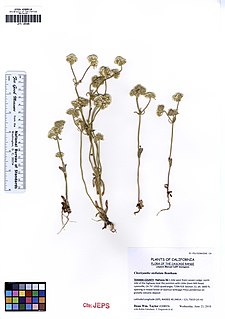
Chorizanthe stellulata is a species of flowering plant in the buckwheat family known by the common name starlet spineflower. It is endemic to California, where it grows in the dry woodlands of the low mountains and foothills along the central part of the state, such as the Sierra Nevada foothills. The plant takes an erect form, reaching up to 30 centimeters tall. The leaves are located at the base of the plant, and there is also a whorl of leaves at mid-stem. The inflorescence is a dense cluster of flowers, each flower surrounded by hairy, bristly white bracts tipped with hooked awns. The flower is 4 or 5 millimeters long and white to pink in color.
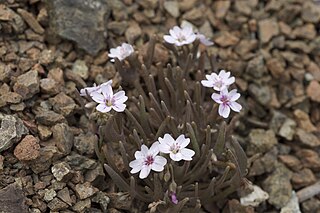
Claytonia gypsophiloides, known by the common names gypsum springbeauty and Coast Range claytonia, is a species of wildflower in the family Montiaceae.
Cleomella parviflora is a species of flowering plant in the cleome family known by the common name slender stinkweed. It is native to eastern California and western Nevada, where it grows in desert and sagebrush scrub in the Mojave Desert and southern parts of the Great Basin. It is an annual herb producing a smooth, hairless, reddish stem up to about 45 centimeters tall. There are a few leaves, each made up of three elongated, fleshy leaflets. Most of the flowers are located in a raceme at the tips of the stem branches, and there may be a few solitary flowers in the axils of the leaves. Each flower has four tiny pale yellow petals, each about 2 millimeters long. The fruit is a lobed, valved capsule which hangs on the tip of the remaining flower receptacle.

Aliciella micromeria is a species of flowering plant in the phlox family known by the common name dainty gilia. It is native to the western United States, especially the Great Basin. It is a small herb producing a thin, branching stem up to about 14 centimeters tall. It is coated thinly in soft hairs. Several deeply lobed leaves 1 to 6 centimeters long are located in a basal rosette at ground level around the stem. There are smaller, unlobed leaves along the stem. The inflorescence produces white or lavender flowers each about 3 millimeters wide.
Aliciella triodon is a species of flowering plant in the phlox family known by the common name coyote gilia. It is native to the American desert southwest from California to New Mexico, where it grows in desert habitat such as scrub and woodland. This small herb produces a thin, glandular stem not more than about 13 centimeters tall. The stem is surrounded by a basal rosette of fleshy, sharp-lobed leaves each up to 2 centimeters long. There are sometimes smaller, unlobed leaves on the stem itself. The inflorescence is a solitary flower or loose array of two or three flowers each about 5 to 7 millimeters wide. Each flower has a hair-thin tubular throat opening into a whitish corolla. The corolla lobes each have three distinct teeth.
Calyptridium pygmaeum, synonym Cistanthe pygmaea, common name pygmy pussypaws, is a plant species endemic to California. It has been reported from Riverside, San Bernardino, Inyo, Tulare and Fresno Counties, in pine and subalpine forests at elevations of 1900–3550 m.















